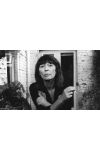
15 Jan 2014 02:58:59
Beryl Bainbridge
In 1967 Austin Davies purchased a house for his ex-wife and family at 42 Albert Street, in Camden Town, initially occupying the basement flat before making the house over to Bainbridge when he emigrated to New Zealand. Albert Street remained Bainbridge's home for the rest of her life, increasingly a showcase for her idiosyncratic taste, while offering irresistible copy for interviewers and journalists. To gain entry visitors had to squeeze past a stuffed water buffalo which blocked the hallway, while in the window of her bedroom sat a lugubrious, life-sized, papier-mache figure of Neville Chamberlain. It was impossible to avoid the collection of plaster saints, including one of St Thérèse of Lisieux, positioned close to the bed, though as the years wore on, she disclaimed orthodox devotion, declaring that she was "a lapsed convert" ("Beryl, come on down", the Observer, 25 October 1998).
Michael Foot
Commanding on the platform, in person he could often seem shy, modest, almost tongue-tied. He was always a rebel and an iconoclast who became a unique propagandist of democratic socialism, British style, yet came from a comfortable, patrician background. He celebrated the radicalism of his various literary subjects, but his admired authors included Swift, Burke, and especially Disraeli. He proclaimed a creed of universal brotherhood, and adored Wales, yet he remained deeply English, strongly committed to the history of England, its liberties and national identity, its commitment to parliamentary politics and tradition of radical nonconformity.
A football steward at Selhurst Park once asked him if he was carrying an offensive weapon. In reply he showed him a copy of the works of Milton, which he claimed was one of the greatest weapons in English history. As always, they let him in.
Alex Higgins
In 1972 Higgins qualified for the world professional championships. He wanted to be promoted under the nickname Alexander the Great, but his promoters preferred the alliterative Hurricane Higgins to draw attention to his speed of play: "Alexander the Great was a figure in history", he observed. "A hurricane was only a strong wind" (Higgins and Francis, 50). The new nickname stuck, and he lived up to it by beating John Spencer 37–32 in the final at Selly Park British Legion in Birmingham. Not only was he the first qualifier ever to win the title, he was also the sport's youngest world champion.
While his first world championship had not been televised, Higgins, always a colourful figure with a less than reverential attitude towards the sport's establishment, became one of snooker's major stars.
Alexander McQueen
Always seeking to subvert the sartorial status quo, dark and sexually explicit themes were rampant on McQueen catwalks. Ideas of gender construction fascinated him. In 2009, the only time he designed for the stage, he created the costumes for Eonnagata, a production based on the life of the Chevalier d'Eon, a cross-dressing secret agent for Louis XV. Bondage was another omnipresent manifestation of the erotic tension that coursed throughout the whole of his work, artfully married with strict tailoring. He liked to use fearsome masks and gags and had a bad reputation for sartorial sadomasochism among models. For instance, La Poupée (spring/summer 1997) featured a black model restrained by a metal cage attached to her limbs and model Abbey Lee Kershaw fainted in 2008 after McQueen cinched her too tightly into a restrictive corset. His professed goal was to "empower women"; he wanted to "be afraid" of the women he dressed (American Vogue, April 2010).
Bernard Matthews
Although he came to epitomise, for some, the worst aspects of mass production and factory farming, he played an important part in changing British eating habits, turning turkey and chicken from luxury foods to food affordable by all. It has been estimated that British consumption of poultry multiplied 25-fold per capita between 1950, when Matthews first started breeding turkeys, and 2010, when he retired.
Norman Wisdom
The act was less about material and more about the finesse with which it was performed. In 1946 a Stage reviewer said it was "an outstanding example of personality making comical bricks out of mere wisps of straw" (The Stage, 3 October 1946). Wisdom was conspicuously short of stature, and much of his appeal relied on playing the little man, the loveable, low-status buffoon. As he put it in an early interview, "My outlook … is coloured by the fact that we laugh at the mistakes and misfortunes of others" (The Stage, 22 April 1948). In this respect he resembled an older generation of comics such as Charlie Chaplin and Laurel and Hardy, performers he would encounter as his career progressed.

